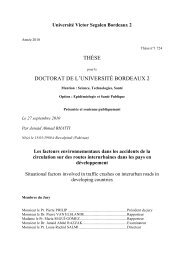Télécharger le texte intégral - ISPED-Enseignement à distance
Télécharger le texte intégral - ISPED-Enseignement à distance
Télécharger le texte intégral - ISPED-Enseignement à distance
- No tags were found...
You also want an ePaper? Increase the reach of your titles
YUMPU automatically turns print PDFs into web optimized ePapers that Google loves.
Annexes 187Estimation of linear mixed models with a mixture of distribution for the random effects 169Tab<strong>le</strong> 1 Estimates and standard errors of the heterogeneous linear mixed model with two components of mixturefor the height of schoolgirls using HETMIXLIN (the proposed direct maximization using a Marquardt algorithm) andHETNLMIXED (Spiessens et al. SAS-macro using an EM algorithm) and estimates of the heterogeneous linear mixedmodel with three components of mixture using HETMIXLINParameter HETNLMIXED (G = 2) HETMIXLIN (G = 2) HETMIXLIN (G = 3)Estimate S.E. a Estimate S.E. b Estimate S.E. b 1 0.68 0.14 0.68 0.12 0.50 0.18 2 0.32 0.32 0.30 0.11 3 0.20 01 82.8 1.12 82.8 0.91 84.2 1.18 11 5.38 0.091 5.38 0.086 5.32 0.10 02 81.9 2.01 81.9 1.52 81.7 1.12 12 6.44 0.18 6.44 0.15 6.47 0.12 03 79.4 2.19 13 5.60 0.20var(u 0i ) 6.47 4.94 6.47 3.13 3.50 2.39cov(u 0i , u 1i ) 0.13 0.40 0.13 0.35 0.32 0.13var(u 1i ) 0.034 0.056 0.034 0.030 0.030 0.024 0.69 0.10 0.69 0.063 0.68 0.06-2L 166.67 165.94AIC 351.35 355.87BIC 360.32 367.82a Standard errors obtained using Louis’s method.b Standard errors obtained using the inverse of the Hessian matrix and the -method for the component probabilities and thevariance parameters.by HETNLMIXED since it converges toward a nonpositivedefinite ˆD matrix. Indeed, HETNLMIXEDuses the NLMIXED procedure which does not constrainD to be positive definite.4.2. Cognitive decline in the elderlyThe second examp<strong>le</strong> illustrates the use of heterogeneouslinear mixed models with our estimationmethod on a large data set as it can beencountered in epidemiological studies. The aimof this analysis is to describe, in a cohort of elderlysubjects, the heterogeneity of the evolutionof the Mini Mental State Examination (MMSE),the most important psychometric test to evaluatedementia and cognitive impairment, and to comparethe classification of subjects stemmed fromthe mixture model with the dementia diagnosis.The MMSE score ranges from 0 to a maximum of30 points.Data come from the French prospective cohortstudy PAQUID initiated in 1988 to study normal andpathological ageing [19]. The cohort includes 3777subjects of 65 years and older who lived at homein Southwestern France at baseline. Subjects wereinterviewed at baseline and were seen again 1 (T1),3 (T3), 5 (T5), 8 (T8) and 10 (T10) years afterthe baseline visit (T0). At each visit, a battery ofpsychometric tests was comp<strong>le</strong>ted and a diagnosisof dementia was carried out. In this analysis,we excluded data from T0 because of a <strong>le</strong>arningeffect previously described for the cognitive testsbetween T0 and T1 [20]. We studied the evolutionof the MMSE between T1 and T8 for subjects free ofdementia till T5 and compared the estimated classificationwith the dementia diagnosis at T8 and thenwith the health status at T10. We excluded subjectsnot seen at T8 to ensure that we had their diagnosisat this visit. This <strong>le</strong>ads to a samp<strong>le</strong> of 1392 subjectshaving between 1 and 4 measures of the MMSE betweenT1 and T8.The model is a quadratic function of time adjustedon covariates associated with cognitive evolutionin order to exclude heterogeneity introducedby known factors. The time (t ij for subject i atvisit j) is the negative time between the measurementand the visit at T8 (time is zero for diagnosistime at T8). We model the square root ofthe number of errors to satisfy the normality assumptionof the error terms. The model is writtenas:√Y ij = 30 − MMSE ij= ˇX ij + u 0i + u 1i t ij + u 2i t 2 ij + ij (13)
















